


Aqueous solutions and precipitates of molybdenum
Molybdenum has a rich aqueous chemistry, but its chemistry is hard to understand and still it only is partially understood. The chemistry, however, is nice and colorful. Molybdenum does not form simple aqua ions. It does form many colored complexes, especially at lower than +6 oxidation states. The most stable oxidation state for molybdenum in aqueous solution is +6, and this is in anionic species. These anionic species have remarkable complexity, they are polymolybdates of general formula [xMnO3.yO]2y–., the simplest one being MnO42- (x and y both equal to 1).
At lower oxidation state, the chemistry is even less understood. Molybdenum forms intensely deep blue compounds, when it is in the +5 oxidation state, it forms red/brown clear solutions, when in the +3 oxidation state.
![]()
Oxidation state +3
A solution in oxidation state +3 is obtained by dissolving a molybdate(VI) compound in moderately concentrated hydrochloric acid (15% to 30%) and then adding some zinc metal to this. As soon as the zinc is added, hydrogen gas is produced, and a brown/red compound is formed as well. At low concentration this looks yellow, but when the concentration increases it becomes red/brown.
The pictures below show the addition of powdered zinc to a solution of a molybdate(VI) compound in moderately concentrated hydrochloric acid. The picture at the left shows the liquid, immediately after adding the zinc. The picture at the right shows the same test tube, somewhat later.
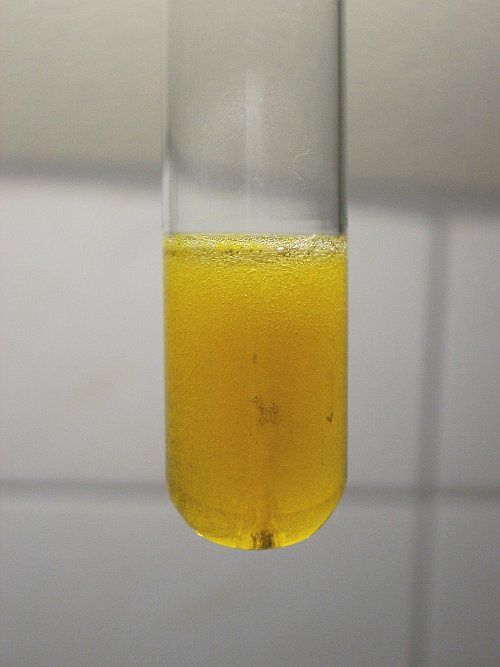
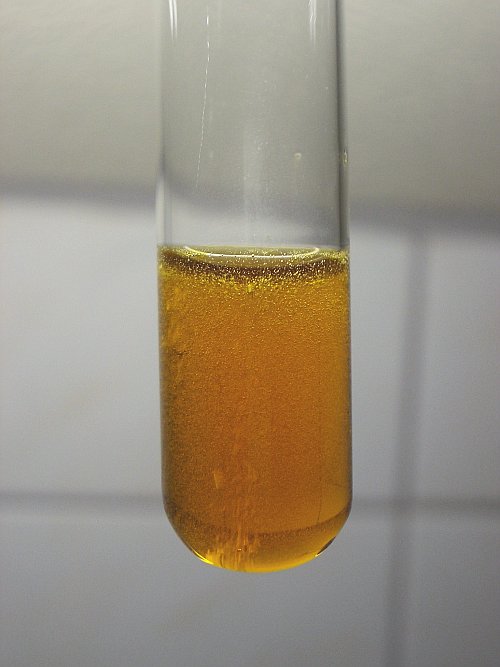
When all zinc has dissolved, then a red/brown solution remains.
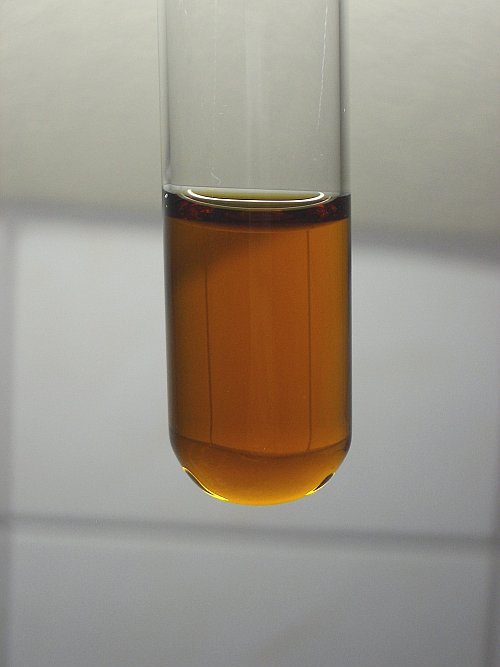
When this solution is allowed to stand in contact with air, then finally it becomes colorless again, due to oxidation of the red/brown compound by oxygen from the air. This process takes a few days in an open test tube.
This red/brown compound most likely is a complex of molybdenum with the chloride ion. A similar compound is formed with moderately concentrated hydrobromic acid and zinc, but not with sulphuric acid or nitric acid.
When the red/brown solution is mixed with a large excess of concentrated solution of sodium hydroxide, then a brown/green precipitate is formed. This is molybdenum(III) hydroxide, Mo(OH)3. The pictures below show the precipitate immediately after adding the solution of NaOH and after some time, when the precipitate has settled at the bottom.
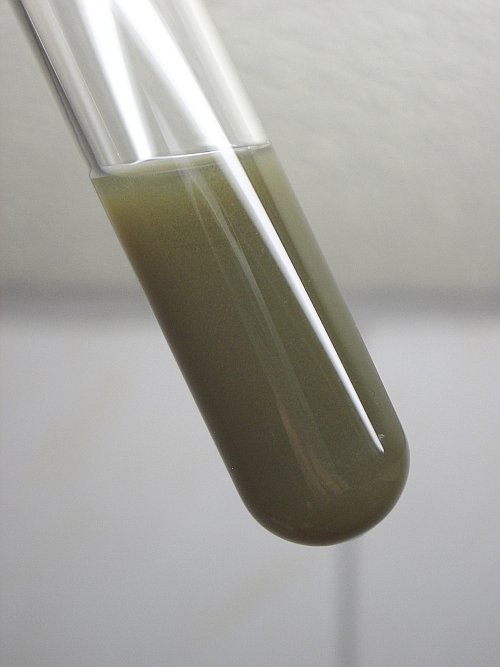
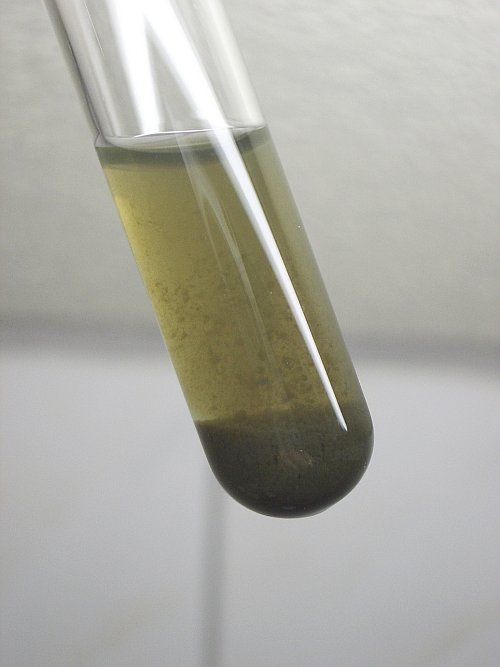
![]()
Oxidation state +5
When a solution of a molybdate(VI) is prepared in dilute hydrochloric acid (concentration approximately 1 M) and zinc metal is added to this, then the solution becomes intensely deep blue, almost black. If the zinc is allowed to stay in contact with the solution for a much longer time, then the solution becomes brown. The deep blue color is caused by mixed oxidation state compounds, with empirical formulas like Mo5O14, which has Mo in oxidation state +5 and in oxidation state +6. This empirical formula, however, does not tell anything about the real compound. In reality, the blue compounds, frequently called "molybdenum blues", have an amazingly complicated structure, and a single unit can consist of hundreds of atoms of Mo, O, OH-groups and H2O-groups. The molybdenum blues are not true solutions, they are suspensions of solid matter. At very high dilution, they look like solutions, but probably they are colloids.
The picture at the left shows the result of adding zinc powder to a solution of molybdate(VI) in dilute hydrochloric acid. The picture at the right shows a highly diluted solution. This nicely shows the beautiful deep blue color.
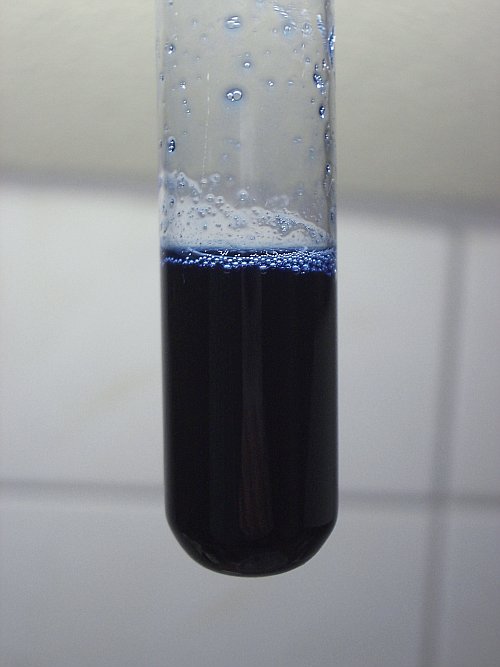

![]()
Oxidation state +6
Anionic species of molybdenum in the +6 oxidation state are colorless. The anionic species have a very complicated chemistry, not from a redox point of view, but highly condensed species can be formed, which strongly depends on pH and concentration. Some examples of molybdenum(VI) species are MoO42- and Mo7O246-. Salts of both anions are available commericially. Many more molybdenum(VI) species exist and they hardly can be characterized as precise entities. Solutions of all of these species are colorless. The picture below shows a solution of (NH4)6Mo7O24 in water.
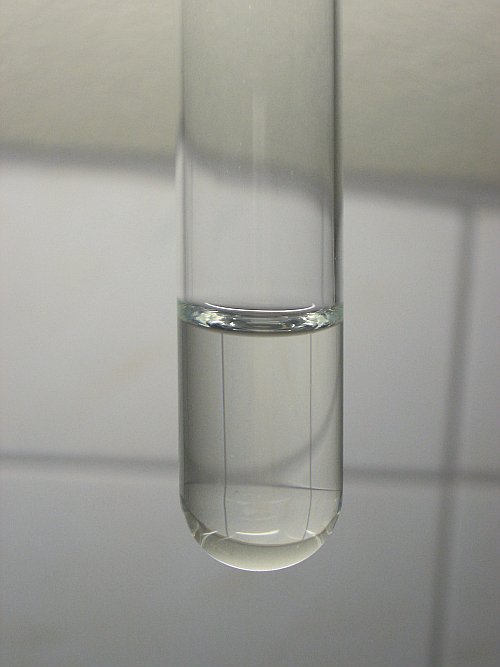
back to solutions/precipitates main page
back to miscellaneous main page